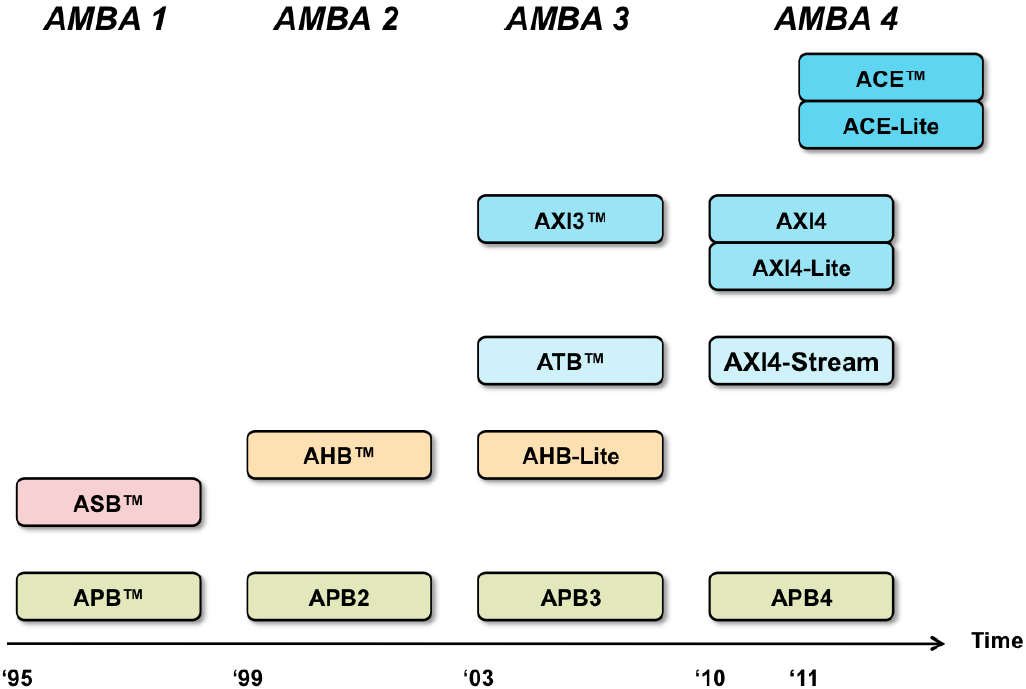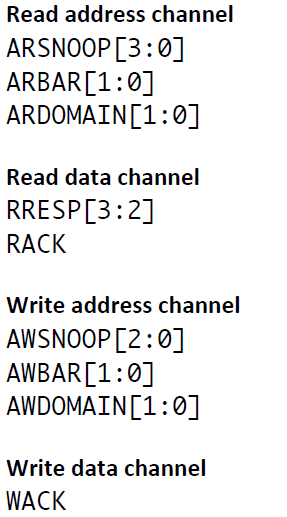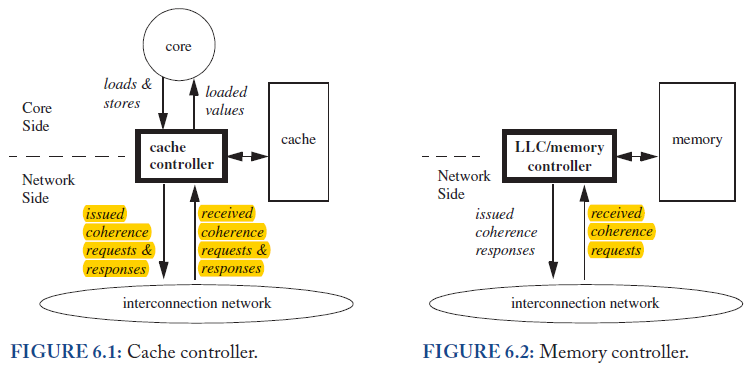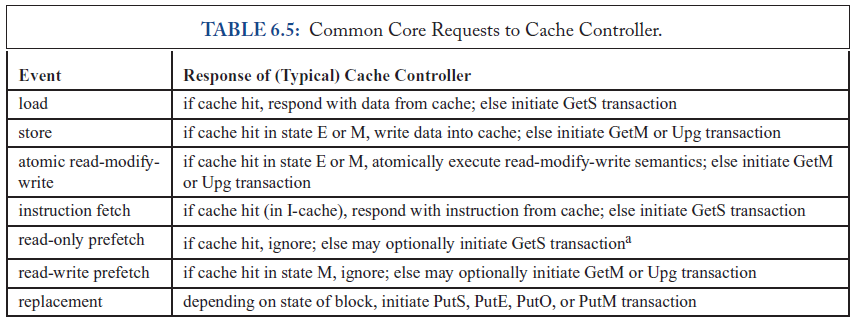提高一个系统的performance,有两种办法:
1) 不断提高一个core的performance,手段就是不断提高freq,减小Vt,这样都会在增加power(dynamic,leakage)
2) 增加processor的个数
arm的big-little processor cluster采用的就是第二个办法,通过Power Gating和DVFS也尽量的减小了功耗。
但是multiprocessor的另一个问题就是cache coherence的问题。
针对cluster内部,arm采用MPCore multi-core coherency technology,
1) 实现了一个基于MESI的cache coherency protocol,并且,增加了一些feature,
direct cache-to-cache copy of clean data,direct cache-to-cache move of dirty data in cluster。
不需要写会main memory,
2) 还包括一个模块SCU(Snoop Control Unit),保存所有的L1 data cache tag,作为一个directory,来减少broad-cast的总线带宽浪费,
3) MPCore technology,支持一个可选的ACP(Accelerator Coherency port),accelerator可以读写processor cluster内部的cache,
但是processor 不能拿到accelerator的cache,也无法保证和其cache的一致性。
针对多个cluster之间,可以通过AMBA4的ACE protocal(AXI Coherency Extensions)来实现。
1) ACE和ACE-lite,引入了system-level coherency,cache maintenance,DVM(distributed virtual memory),barrier transaction support。
2) ACE本身是支持5状态的MOESI cache coherency model的,master可以支持MESI,MOESI,MEI等,都兼容,
3) ACE需要与指定的system interconnect一起使用,来处理所有shared transaction,
interconnect在拿到master发送的transaction时,可能会speculative reads,或者等待snoop resp,
interconnect可能包含一个directory,snoop filter,或者broadcast snoop到所有的master,
4) ACE支持的system level coherency,是指所有的master,包括GPU,DMA,dissimilar CPU。
AMBA的发展路线图:
1) AXI4支持了long burst,不在支持write interleaving;
2) AXI4-stream,是专为大批量数据传播的应用,是一个point-to-point 协议,没有了address channel,只有data channel;
3) AXI4-Lite,是一个简化版的AXI4,主要用在需要apb的peripheral中,做升级。

Software-Based Coherency Approach:
cache的coherency也可以在software中解决,在之前的single processor,just small L1 cache中;
但是,目前的SoC中,都是multiprocessor,并且有L2,L3等cache,还有其他的cache master,GPU等。
用软件实现的可能性已经很小,难度太大,性能也很低,
Hardware-Based Coherency Approaches:
1) Snooping cache coherency protocols,所有的master都“listening in”所有的shared-data transactions,
read,操作,addr输入,所有的processor检查自己的cache中,是否有该addr,有的话,直接返回ack,不再访问memory;
write,操作,addr输入,所有的processor检查自己的cache中,是否有该addr copy,需要invalid掉。
这种方式的coherency tranffic是比较大的,N(N-1),因为需要broadcast到所有的processor中,在processor越来越大时,
效率会越来越小。
2) Directory-based cache coherency protocols:系统中,有一个single directory,保存系统中cache line的list,
这样,master发出一个transaction,首先查找该directory,然后directed cache coherency traffic到某些master中,减小coherency traffic。
最好的情况下,traffic是2N,最差的情况下是N*(N-1+1),因为还需要首先检查directory。
这种方式,需要一块很大的on-chip RAM,如果放在off-chip,又增加了系统的latency。
实际应用中,可以做些优化,比如Snoop based system,可以加些snoop filters,来减小coherency traffic。
ACE对于snoop和directory-based的方式,甚至其他的hybrid类型的protocol都是支持的,
ACE在AXI的基础上,增加了三个channels,来发送和接收coherency transaction,

在现有的channel中,增加了新的信号:
ARSNOOP和AWSNOOP,表示对shareable transactions的snoop transactions;
ARBAR和AWBAR,用来表示barrier signal;

ACE-Lite,在AXI的基础上增加了新的signals,却没有增加新的channels,
ACE-Lite master主要用来snoop其他的ACE-compliment master,
但是themselves并不能被snooped。
以CCI400的interconnect,为例,支持两个clusters CPU,三个ACE-lite I/O coherent master,

ACE引入了很多new transactions,一般可以根据memory attribute,进行分组。

ACE-Lite I/O Coherency,ACE-Lite Master可以实现,Non-shared,Non-cached,Cache Maintenance transaction,三种group
的transaction,实现了uncached masters来snoop ACE coherent master,
比如Gigabit Ethernet 直接读写cached data shared with CPU。
DVM(Distributed Virtual Memory),用来保证MMU内部TLB的一致性,支持TLB Invalidation,Brach Predictor,Instruction cache Invalidation。
cache coherence基础:
cache coherence设计的主要目的是,在multicore的系统中,多个caches的表现与sing-core system相同。
cache coherence的define,可以描述为,多个memory copy,允许single-writer-multiple-reader(SWMR),在某个
logic time中,只存在最多一个core写A,或者多个cores read A。
coherence的granularities,一般是安装cache line的大小来定义。
必须在写操作,之后禁止对同一地址的读操作,直到所有的cache都发反馈信号(ack),表示该cache已经invalid或者update。
在memory system中,cache controller负责issue coherence req和received coherence rsp,
memory controller负责,received coherence req和issue coherence rsp,
两者之间通过interconnect来连接。

coherence protocol有两种,snooping和directory,transactions/action不同,但是stable state是相同的。
1) stable states,很多的coherence protocol都是MOESI model的子集,
M(Modified),表明一个cache line是valid,exclusive,owned,可能还是dirty的。
S(Shared),表明一个cache line是valid,但是不是exclusive,不是dirty,不是owned的。
I(Invalid),表明一个cache line是invalid,或者说是不可读写的,
MSI是最基本的protocol status,还有两个可扩展的status,O和E,
O(Owned),表明cache line是valid,owned,但是不是exclusive,而且可能是dirty的,在main memory中的data很可能是stale的。
E(Exclusive),表明cache line是valid,exclusive,并且是clean的。

2) 由cache controller发出的common transaction:

3) common core对cache controller的req:

4) snooping protocol,broadcasting a req message到所有的coherence controller,这些req到每个core的order是可以不不定的。
看具体interconnect的实现。
directory protocol,unicast该req到具体的cache controller或者memory controller。
snooping结构简单,但是不易scale to large numbers of core,
directory,可以scale到large num of core,但是增加了每笔coherence req的lantency。
5) 当一个core write cache line时,该coherence protocol作何动作,可以分为invalidation/update两种,与
snooping和directory无关。
invalidation,当一个core发出write cache line的操作时,其他cache copy都被更新为invalid。
update,当一个core发出write cache line的操作时,其他cache copy都被update为最新的值。
实际中update用的很少,因为update的操作,相对还是比较占用bus的bandwidth,而且这种方式
会将memory consistency model复杂化,因为原子操作中,如果出现多个cache更新该cache中的数据,
情况会很复杂。
Cache和MMU之间的结构:
按照工作原理来分,cache有physical index physical tagged, virtual index virtual tagged, physical index virtual tagged等几种工作方式。
1) physical index physical tagged,cache仅仅针对物理地址进行操作,简单粗暴,而且不会有歧义。
缺陷:在多进程操作系统中,每个进程指令和代码都是以虚拟地址的方式存在,cpu发出的memory access的指令都是以虚拟地址的方式发出,
所以对于每一个memory access的操作,都要先等待MMU将虚拟地址翻译为物理地址,这样还是增加了操作的latency。
2) virtual index virtual tagged是纯粹用虚拟地址来寻址,由于多个virtual address可以对应一个physical address,每一行数据在原有tag的基础上
都要将进程标识加上以区分多个进程之间的相同地址,而在处理共享内存时,共享内存在不同的进程中的虚拟地址不相同,如何同步是个问题。
结构太复杂
3) virtual index physical tagged方式现在使用的比较多,virtual index的含义是当cpu发出一个地址请求之后,低位地址去和cache中的index匹配
(低位一般都是页内偏移地址,virtual address与physical address低位部分相同),
physical tagged是指虚拟地址的高位地址去和mmu中的页表匹配以拿到页的物理地址,
这样virtual index的匹配操作和smmu的转换操作可以并行工作。
ARM MPCore的cache结构,L1 Cache一般放在processor里边,可以分为L1 data cache,L1 instruction cache。(8KByte----64KByte)
L1 instruction cache,不但能做instuction caching,还可以做Dynamic branch prediction,
一些使用PC作为目的寄存器的操作,BXJ指令,Return from Exception的指令,不会做prediction;
多是2-way set associative结构,64byte cache line。
L1 data cache,是一块physically indexed physically tagged cache,
内部包括一个internal exclusive monitor,用来存放当前有效的exclusive访问的列表,可以直接返回EXOkay,
可以产生ACE transaction和CHI transaction,
多是4-way set associative结构,64byte cache line。
L2 cache包括一个集成好的SCU(连接到一个cluster内的4个cores),一个L2 Cache,(128KByte------2MB)
SCU中包含L1 Data cache tags来做4个core之间的coherency,
L2 cache中不支持snoop hardware操作,来保证cache之间的coherency,可以配置选择ACE或者CHI连接到main memory
Physically index, Physically tagged cache,8ways-----16ways。
SCU支持direct cache-to-cache transfer,dirty cache lines to be moved between cores,内建tags filter,来发送指定的
coherent requests。